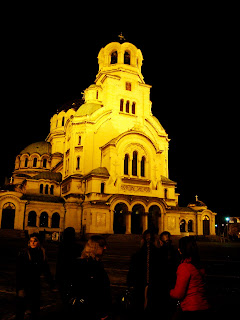After a fun night out Thursday and a relaxing Friday in which my friends and I hiked our favorite little mountain and sat on a peak overlooking our city, I spent the next two days in Sofia, the capital of Bulgaria, an almost 2 hour bus ride away. On Saturday, our school organized a trip to the opera in Sofia. We spent the middle part of our day shopping in the Mall of Sofia, grabbing mocha lattes here and there, and simply enjoying being in a mall, which I haven’t since I left the States back in the beginning of January. When nighttime rolled around, we made our way to the opera house, which was stunning. We enjoyed a glass of champagne before the show and some conversation, being the sophisticated ladies that we are ;) I had never been to an opera before so I was beyond excited to experience it, and it truly was a beautiful performance.
 |
| St. Alexander Nevsky Cathedral in Sofia |
 |
| National Historical Museums backdropped with beautiful mountains |
On Sunday, we boarded a bus for the second day in a row to Sofia. This time, we were taking a history field trip to the Boyana Church and the National Historical Museum. Nestled on the outskirts of Sofia in snow-covered woods, the Boyana Church is a medieval Bulgarian Orthodox church, dating back to the 11th century. It is known for its frescoes from the year 1259, a total of 89 scenes and 240 human figures. We got the special opportunity of going inside and learning about some of the ancient artwork (unfortunately, no photos allowed). Next stop: National Historical Museum. This place was gorgeous. It is the largest museum in Bulgaria, and it has the largest archaeological and historical archives in all the Balkans. It displayed wonderful artifacts and history along the timeline of the existence of civilization in Bulgaria, beginning with the Neolithic Period around 9000 BC. The building in which the museum is currently housed used to be the headquarters of the Communist leaders of Bulgaria, before the fall of the Communist government in 1989. Perhaps one of the most beautiful artifacts was the Golden Treasure of Panagyuzishte from the Thracian Period. All 24-karat gold, the treasure is dated from the 4th-3rd centuries BC. It was not discovered until 1949. A beautiful sight to look at.
 |
| Golden Treasure of Panagyuzishte from Thrace |
I had the opportunity to adventure on another field trip this past week. For my environmental science class, a topic which I truly am passionate about, we ventured to the recycling center here in Blagoevgrad. Though I know this may not sound like the most exciting or beauteous of sites to see, it was truly eye opening to see the working conditions for these people and to actually watch a day in the life of a Bulgarian. Even more interesting was the massive amounts of garbage that can be recycled, yet we rarely take the time to do. The center was no small place and the amount of garbage and recycled material was no small number, and this is from one city in Bulgaria, one of the few countries in our world in which population rates are decreasing. I can only imagine the amount of garbage that other overpopulated parts of the world generate, and our entire world? Well, those numbers are almost unimaginable. I know this isn’t the loveliest of topics, but it is an overwhelming bit of knowledge that shows the human impact on our world.
On a different note. TOMORROW. SPRING BREAK. Even in capital letters, this doesn’t denote how incredibly thrilled I am to be taking off tomorrow from Sofia airport. First stop, Barcelona until the 28th. Then to Rome until the 2nd, then Florence, Bologna, and Milan to round out the last five days of our break. Food, sites, history, new oceans, new shores, new lands waiting to be discovered...did I mention food? Spain and Italy, you better be ready to welcome us with open arms.
No comments:
Post a Comment